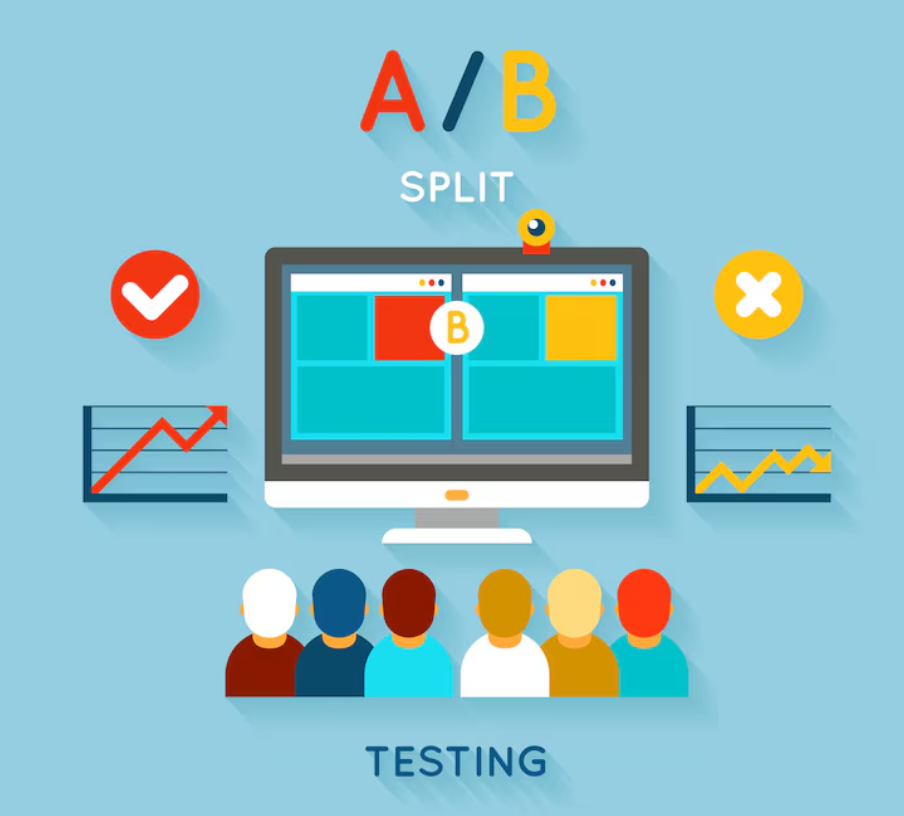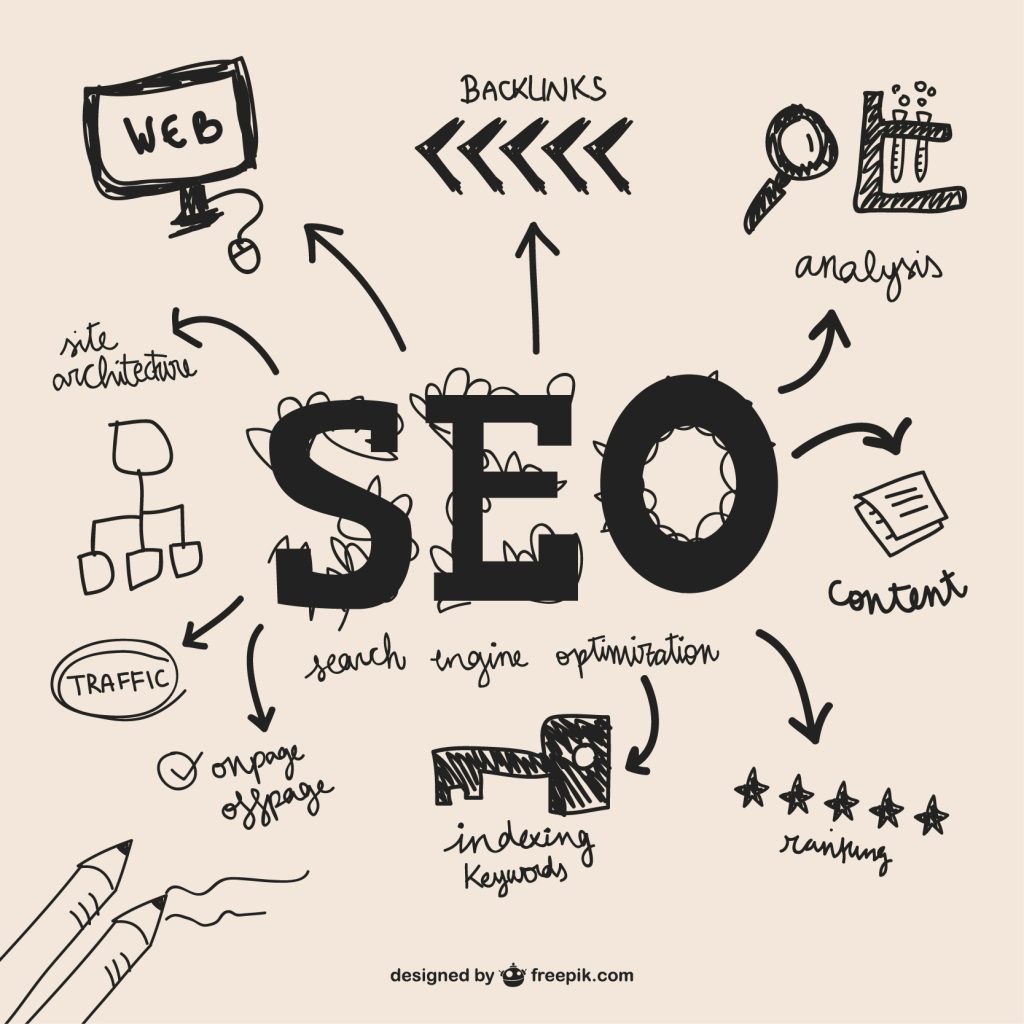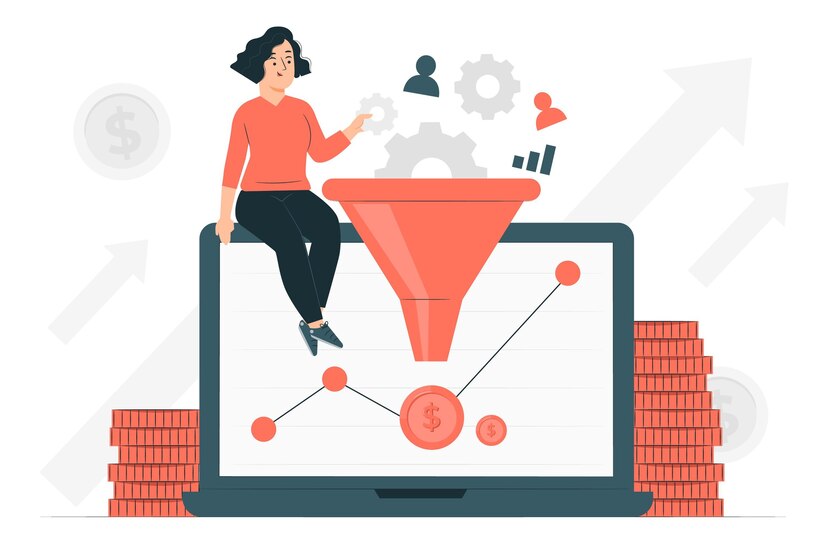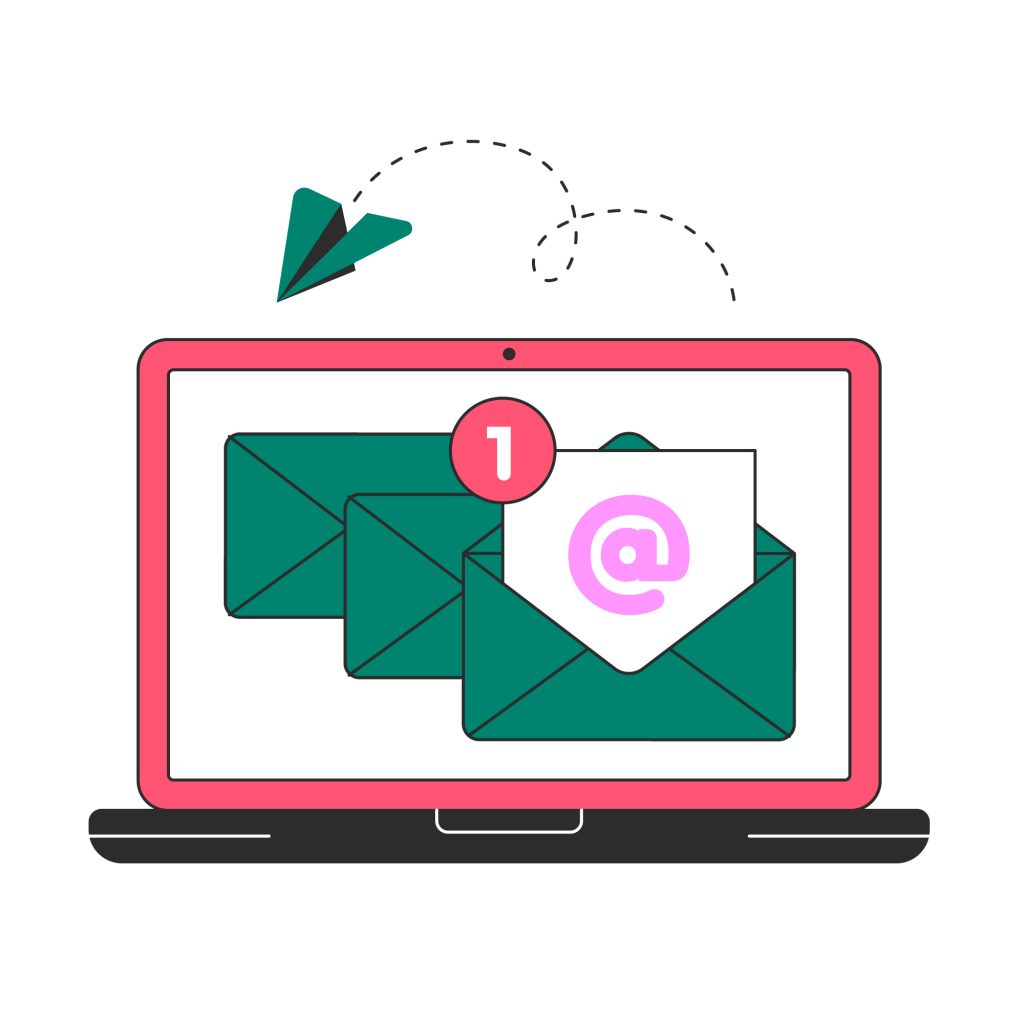How to Quicky Increase E-commerce Conversion with Simple A/B Testing

Before launching your campaigns, it’s a good idea to create many variations of anything. This is where A/B testing comes into play. It aids in optimizing the success of marketing initiatives designed to increase website visitors. Many marketers are not using A/B testing effectively, despite the fact that it is one of the most effective and proven techniques to evaluate your marketing efforts and conversion funnel. What do they not have? Is it worthwhile? We are available to address any additional queries you may have! What is A/B Testing? Simply said, A/B testing is an experimental procedure that compares two versions of website elements, such as a landing page, exit-popup, sidebar, navigation menu, or any other marketing asset, in order to assess the performance differences. It is also known as split testing or bucket testing. To determine which version of the element maximizes conversions and drives the selected business metrics, different segments of website users are presented the two versions of the element. Let’s examine the specifics of A/B testing. Why Is A/B Testing Actually Necessary? The first step in marketing is to create a website or landing page. After the design is complete, you must choose the strategies that will boost sales and conversions. Here’s when A/B testing comes in handy. A/B testing can benefit your company in the following ways: One of the most popular methods for conversion optimization nowadays is A/B testing. Its growing popularity is matched by the expansion of tools for conducting A/B testing and analyzing the outcomes. Key Elements of A/B Testing for Higher Conversions Not all A/B testing components yield the same results. To boost conversions, focus on testing impactful elements. Call-to-Action (CTA): Your CTA drives action, influencing whether visitors purchase, sign up, or engage further. Test variations like background color, text, and placement to see what improves conversions. Headlines & Copy: Headlines are the first thing visitors see. If they aren’t engaging, visitors may leave. Ensure they are concise, attention-grabbing, and clear. Test different fonts, styles, and messaging to find what resonates with your audience. Popups & Overlays: Popups can be effective when used correctly. Test different designs, copy, and animations to find the best balance between grabbing attention and avoiding annoyance. Subject Lines: A compelling subject line is critical for email marketing success. With an average open rate of 22%, experiment with phrasing, questions, emojis, and power words to boost email open rates. Images & Videos: Visual content is a major marketing tool, with 49% of marketers considering it essential. Test different visuals, such as infographics, videos, and product images, to see what enhances user engagement. Landing Pages: Landing pages are vital for promoting products and services. Use heat maps to track user clicks and test different layouts, product descriptions, and testimonials to optimize conversion rates. Social Proof: Reviews and testimonials are powerful conversion tools. Test various forms of social proof, such as star ratings, customer quotes, or badges, and experiment with their placement and format to find what works best for your audience. Types of A/B Testing After covering A/B testing, let’s explore other testing methods. Split URL Testing: Unlike A/B testing, where minor front-end changes are made, split URL testing involves designing a completely new version of the web page. Traffic is divided between different URLs to compare their performance, helping determine which version converts better. Multivariate Testing: This method tests variations of multiple page elements simultaneously to find the best combination. It’s more complex and ideal for advanced marketing strategies, allowing marketers to save time by testing multiple elements at once. Multipage Testing: This type of testing evaluates changes to specific elements across multiple pages. In Funnel Multipage Testing, entire sales funnel pages are redesigned and tested. Classic Multipage Testing focuses on adding or removing specific elements like testimonials or images to assess their impact on conversion rates. These testing techniques offer more advanced options for optimizing website performance, complementing traditional A/B testing. Step-by-Step A/B Testing Guide to Improving Lead Generation & Conversions Rate A/B testing offers a methodical way to determine which of your marketing campaigns performs better. But it must be carried out using a clear procedure. The following procedures are part of the A/B conversion rate testing. Select a variable and establish objectives and KPIs You have to conduct research and make conclusions before you can conduct an A/B test. You can test as many aspects as you like, but you must first prioritize which elements should be examined first by choosing those with the highest payout. To ensure that every version is handled equally, you have to configure the test’s parameters. After determining the variable, you must select your success metric. Are conversions your goal? Shopping cart disappearance? Rate of bounces? Sales? When choosing the objectives and carrying out your tests, you must eliminate as many “gut feelings” and presumptions as you can. Predefining your constants and variables can help you focus on the right things and prevent you from seeing misleading results. Choose the Page and A/B Test Elements Start with the most significant or popular webpage you have. This might be your best-performing landing page or homepage. Whichever path you take, make sure it’s directly related to your metrics. Once the page has been chosen, analyze every element to see what can be enhanced, including the navigation menu, popup window, CTAs, images and videos, reviews, case studies, and so on. Make sure you make a small change to the current content to observe how it affects metrics. Prioritize the pieces based on what you believe will have the biggest impact on conversions. Produce Alternatives Make a variation based on the above hypothesis and compare it with the existing version. To improve your analysis of the findings, just make the changes you decided upon in the previous stage, and only one change at a time. For instance, alter the button size, text, font, color, and CTA when testing your popup window. You can then modify the backdrop picture or input areas. Keep
The Art of Crafting Irresistible Lead Generation Campaigns!

The phrase “lead generation campaign” is more than just a catchphrase in the field of digital marketing; it refers to a critical tactic for drawing in new clients and constructing a strong email list. Your target demographic is drawn in by an appealing lead magnet that sounds like a siren song and offers value. This post explores the skill of developing attention-grabbing lead magnets that turn prospects into devoted followers. Admittedly, not every lead is made equal. Prospective clients who are both financially capable of making a purchase and truly interested in your goods or services are what you need. That’s the point at which B2B lead generating tactics become useful. We’ll look at tried-and-true methods in this article to assist you in luring and developing the best prospects for your company. Defining Quality Leads Quality leads are the lifeblood of any successful sales strategy. They’re not just any contacts in your database; they’re prospects with a high likelihood of becoming valuable customers. A common mistake is confusing quantity with quality. Don’t fall into the trap of chasing after every lead. Focus on those that truly fit your criteria. It’s better to have 10 high-quality leads than 100 low-quality ones. To identify quality leads, use lead scoring systems. Assign points based on demographics, firmographics, and engagement levels. This helps prioritize your efforts on the most promising prospects. Remember, the definition of a quality lead can vary depending on your business model and industry. Regularly refine your criteria based on your successes and failures. What works for one company might not work for another, so it’s crucial to develop a tailored approach. Setting out Goals Developing a comprehensive lead generation strategy begins with setting clear, measurable goals that align with business objectives. By defining SMART goals—specific, measurable, achievable, relevant, and time-bound—you can ensure focus and track progress. For example, a goal might be to “increase qualified leads by 25% in the next quarter.” It’s essential that these goals support broader company objectives, such as revenue growth or market expansion, and that key performance indicators (KPIs) are established to track metrics like conversion rates and cost per lead. Quality leads should be prioritized over sheer volume to improve the chances of conversion. Identifying Your Audience Identifying your target audience is another crucial aspect. This involves creating detailed buyer personas that outline customer demographics, job roles, pain points, and decision-making processes. You should also analyze existing customers to spot patterns and use market research to refine your focus. Audience segmentation is key, enabling you to personalize messaging and marketing strategies. For sales, consider the entire buying committee, including decision-makers and influencers. Finally, evaluating factors like firmographics and technographics helps tailor solutions to your target market’s needs. Together, these steps build a strong foundation for generating high-quality leads that align with your business goals. Creating Valuable and Relevant Content Content marketing plays the major role in generating quality leads. By creating valuable and relevant content, you’ll attract potential customers and establish your company as an industry authority. Focus on addressing your target audience’s pain points and interests through various content types: Consistency is key in content marketing. Develop a content calendar to maintain a steady flow of publications across your chosen platforms. Diversifying your content formats also helps reach a wider audience and cater to various learning preferences, but you should ensure to factor in your audience’s preference and the platform you are sharing it on By leveraging diverse content formats, you’ll increase your chances of engaging potential leads and guiding them through the sales funnel. Email list Lead generation is not complete if there is no email list. By crafting targeted campaigns, you’ll engage potential clients and nurture relationships that drive conversions. Building a robust email list is the bases for successful lead generation without it, who are you going to market to? Start by offering valuable content in exchange for email addresses on your website. Use lead magnets like whitepapers, eBooks, or industry reports to entice visitors to subscribe. Carry out pop-ups and exit-intent forms to capture leads before they leave your site. Once you’ve built your list, segment your list base on necessary category like: Industry, Company size, etc. Segmentation allows you to tailor your messages to specific audience groups, increasing relevance and improving open rates. For example, send product updates to existing customers and educational content to new subscribers. Compelling Email Content Your email content needs to grab attention and provide value to your audience. Remember to test different email elements, such as subject lines, content, and send times, to optimize your campaigns for better performance. A/B testing helps you identify what resonates best with your audience and refine your approach over time. You need to create email marketing campaigns that not only generate quality leads but also nurture them through the sales funnel. At Dgazelle, we specialize in crafting compelling email content tailored to your audience, ensuring you drive conversions and achieve business growth. Choosing the Right Platforms Social media platforms provide significant opportunities for lead generation by identifying, engaging, and nurturing potential clients, ultimately driving business growth. Start by researching where your target clients are active. LinkedIn is typically a strong choice, but platforms like Twitter, Facebook, and industry-specific forums shouldn’t be overlooked. Evaluate platform demographics to ensure they match your target audience, and consider industry trends when making your choice. For example, tech companies may thrive on Twitter, while LinkedIn might be more suitable for professional services firms. Assess content compatibility as well—if your strategy involves videos, platforms like YouTube or TikTok may be worth exploring. Focus on excelling in one or two channels before expanding. Engaging with Leads Once the platforms are selected, create valuable content—articles, infographics, and videos that address your audience’s pain points. Use social listening tools to monitor industry discussions and tailor your approach to individual leads. Share social proof, like client testimonials or case studies, to build credibility. Hosting virtual events or webinars can also attract potential leads. Consistent engagement, including
How These SEO Strategies Made Ordinary Sites Extraordinary!

It’s tempting to set high goals of increased visibility of your website in search engine rankings. Still, it takes work to reach those coveted top spots. You require a thorough SEO content strategy based on user intent, keywords, and audience as well as constant monitoring of the search engine environment. This article examines how your overall search visibility efforts should incorporate high-quality, SEO-driven content. We also demonstrate how to create a successful SEO campaign in 2024 by accounting for Google’s beneficial content update, voice search, AI, and search generative experience. Components of a Successful SEO Strategy Before we get started, let’s take a broad overview. SEO content authoring is a significant part of the overall Google ranking algorithm, but it’s not the only one; over 200 criteria are said to affect a page’s placement in the SERPs. An all-inclusive SEO plan consists of four components: Creating the Basis for Your SEO Content Plan In order for your content to rank highly in search results, it must both meet and exceed reader expectations and outperform pages that currently hold the top rankings. To attract traffic to your website and customize content for user queries, base your strategy on the following elements. Target audience To write SEO content, you must first identify your target audience. What hurts them the most? Where do they search for data? Do they like long-form articles or short-form videos? Make sure your content is relevant to your audience and use a tone that will resonate with them. Industry-specific SEO content techniques differ based on the sector. Look into the keywords that consumers use to find goods and services as well as the keywords that your rivals employ. Local SEO should be a priority for landscapers, event coordinators, plumbers, real estate agents, and car mechanics. Because of the potential impact of their advise, companies in the health and financial industries who publish on “your money, your life,” or YMYL, issues need to pay close attention to quality and subject matter expertise. Content clusters Websites that Google deems trustworthy sources of information typically have higher rankings. To demonstrate competence, increase the topical authority of your website. Instead of focusing on arbitrary keywords, create meaningful content clusters and do in-depth subject analyses. These content clusters function as the backbone of your website and assist you in developing an inventory of articles that consistently illustrate your expertise in a particular field. Outstanding material Although we’ve spent a lot of time discussing Google optimization, it’s equally important to keep in mind that stakeholders, business partners, and potential consumers will read your material. As previously stated, concentrate your SEO content writing on unique articles that benefit users. Ensure that the goals of the helpful content system and the E-E-A-T criteria are met by your material. Key performance metrics Establish goals to monitor the effectiveness of your SEO content strategy and to help you fine-tune your techniques for better results. Select KPIs that accurately represent your goals; for instance, the quantity of impressions can serve as a gauge for brand recognition. Traffic, keyword rankings, click-through rates, session time, and conversions are examples of common metrics. Establish your benchmarks and take regular progress measurements. Steps for Formulating an Effective SEO Content Plan You’re prepared to put the elements of an effective strategy together now that you know what goes into it. This is how to develop a successful SEO content plan that will help you achieve your business objectives and rank better in search results. Recognize your audience Your ability to customize your campaign to your target audience’s needs will improve with increased accuracy about who they are. This entails being aware of their wants, worries, and driving forces at every turn in the purchasing process. If you sell baked products, for instance, find out which factors your target market is most interested in: quality (organic), affordability, or a fix for a problem (gluten-free). Provide stuff that will appeal to them when they are considering, deciding, and becoming informed. Keyword research After determining your target audience, research keywords to determine the search terms they are most likely to employ. Create topic clusters out of the keywords and start creating an SEO content plan. Combining head and long-tail keywords is what you should do. For instance, “artificial grass” is a good term with a lot of searches, but it’s difficult to rank for. Lower search volume long-tail keywords can be your target for greater precision. It is simpler to become visible using certain keywords, like “What are the benefits of artificial grass?” Additionally, long-tail keywords aid in voice search optimization. When interacting with a voice assistant, people usually use conversational language, such as asking, “What trees are native to Maryland?” rather than typing, “Maryland.” Make a content plan. Examine your selected keywords and determine the most appropriate format for every piece of material. In order to increase output, you can outsource the writing of blog articles to an SEO content writing agency, as they are easy to publish. User engagement is boosted via interactive material, such as interactive maps, games, polls, quizzes, and mortgage calculators. Verify that the content is crawlable and indexable. Before publishing, make sure every piece of content is optimized using SEO best practices. Make sure pages load quickly for desktop and mobile platforms, provide internal links, utilize metadata, and format material using headers. Keep in mind that infographics, movies, webinars, pictures, and other visual information cannot be crawled by search engines. To help with indexing and to communicate the significance of the content, you can include transcripts or written summaries. Create an off-page SEO plan. Increase the effectiveness of your SEO content strategy by constructing backlinks from reputable third-party websites within your industry. These linkages can be made in different ways: Involve users You should observe a rise in organic traffic as your pages go up the search results page. Ensure that visitors to your website have an excellent experience. The website should be visually appealing, simple to use, and full
The Most Effective SEO Strategies You Haven’t Tried Yet!

According to Safari Digital, approximately 61% of marketers believe that SEO is the key to online success, which is why modern businesses allocate an average of 41% of their marketing budget to it. In short, taking the time to outline a proper SEO strategy can revolutionize not just your online traffic but your business as a whole. Internet use is at an all-time high given the state of the world today. We are shopping online more than ever, watching more TV and movies than before, and going to enough Zoom meetings to last a lifetime because of the pandemic. Over the years we have seen a huge increase in the importance of SEO for businesses, and we anticipate that it will be much the same in the coming years. So, the question is, how can you design an SEO plan that adapts to the current landscape? With that, here are the steps to create an SEO strategy in 2024: Write for humans first and search engines second With continuous human input, the Google algorithm continues to improve its daily intelligence and better match our way of thinking. Having said that, don’t even try to trick a search engine; there isn’t a smart shortcut or secret recipe for doing so. Prioritize writing for readers over search engines. Your top goal should always be to satisfy your audience’s needs, and you can only do that by creating interesting material that is essentially naturalistic. Stuffing is even more obvious than shoehorned in keywords, so insert them in where they make sense and let driving keywords enhance your content, which is already insightful and worthwhile. Make a list of keywords. Typically, the first stage in any SEO campaign is keyword research. And what’s the greatest method for identifying terms that your ideal clientele uses? Google Suggest. Since these keywords are directly from Google, you can be sure that people are actually searching for them. In addition, longer keywords, also referred to as “long tail keywords,” are typically less competitive than “short tail” terms, making it easier to rank for them even though they have lower search volume levels. To generate a list of about ten keywords, try different keyword searches on Google. Examine Google’s First Page Okay, so you’ve identified a few keywords. The next step is to determine who is currently ranking for those keywords. To do this, simply enter one of the keywords into Google and make a note of any trends you see. For instance, the SERPs for “SEO Tools” are LOADED with tool lists. If you wanted to write about that topic on your website, you should notice that the majority of the first page results are list posts. You should also publish a list post on your blog. Identify Your Competitors You might think of websites that have a lot of common keywords as your competition. Semrush is my go-to tool for competitor analysis in SEO. Their tool can save you a great deal of time and makes the process quite simple. You can see how many terms you have in common with these domains, as well as how much traffic these websites are bringing in, and also you can see how many terms you share overall with each site in the “Common Keywords” column, which is helpful. You can identify at least four or five primary organic competitors by the time you finish this phase. Build Something Better or Different It’s time to produce some really excellent stuff now. Regarding SEO content, you have two choices: There are moments when you desire to create something more and better than what already exists. (also known as The Skyscraper Method.) Nonetheless, there are instances when entirely different content from what is on Google first page is preferable since it makes your work more distinctive. Other times, you want to create something that’s simply better than what’s already ranking on the first page of Google? In this case, you want to publish content that’s 10x better than what’s out there. Incorporate a Hook Obtaining backlinks is important in 2024 if you want to raise your search engine rankings. (And a large number of them.) As they continue to be a significant Google ranking element. To accomplish this, you need find out the reasons why people link to specific pieces of content in your industry. This link is also called the “The Hook”. Next, include that “Hook” into your writing. Data is just one type of “Hook” that you can use to build links to your content. Reason being that your content will be backed up with facts and stats and users will always reference and backlink to this area with stat, invariably giving you more presence in Google search engine Optimize For On-Page SEO There are three core on-page SEO techniques that I recommend focusing on in 2024. the first is Internal Linking. Yup, internal linking still works. But you have to do it right. Specifically, you want to link from high-authority web pages to pages that need more authority. The second technique is short, Keyword-Rich URLs. An analysis of 11.8 million Google search results found something that surprised a lot of people: When it comes to search engine optimization, short URLs generally outperform long URLs. So the best course of action should be Semantic SEO Finally, optimize content for sematic SEO In other words, find words that are related to your target keyword and use those terms in your content Focus On Content Design Perhaps the most overlooked aspect of content marketing is the design. The greatest stuff ever written can be yours. But if it does not appears appealing, it won’t get much traction. Excellent content design doesn’t have to be extremely expensive. These four categories of visual content are actually very simple to create. Charts & Graphs: Try to add a chart in every post because they are so useful as they make data easy to understand. As a bonus, people will sometimes use your chart in a blog post… and link back to you Screenshots and Pictures: To be clear: Don’t
5 Simple Ways to Improve Your Conversion Rate

Conversion rate, often known as CVR, is the proportion of users who have finished an action that they intended to do. A free trial, inquiry, or email newsletter sign-up are all examples of possible actions; however, the action is usually utilized when a user fills out a form and submits personal information. Additionally, a real order on an e-commerce website is referred to as a conversion. If your website is getting a lot of visitors but your conversion rate is still low, there’s probably a problem with your forms, content, site layout, or something else entirely. But, you can be passing up a ton of fresh leads, depending on where the problem is. Ways of computing conversion rates The number of conversions divided by the total number of sessions (site visits) is the formula to get your conversion rate. For instance, if you had 1000 sessions that month and 10 queries, then 10 ÷ 1000 = 0.01 is your conversion rate; expressed as a percentage, this translates to 1%. What differentiates CVR from CTR Conversion rate and “click-through rate,” or CTR for short, are two different metrics that are sometimes misconstrued. Ultimately, their acronyms are nearly identical. However, click-through rate indicates the number of clicks you obtain in comparison to impressions or views when it comes to an email link or advertising campaign. Divide the total number of impressions by the number of clicks to get the CTR. Typical reasons for low conversion rates In general, websites have an average conversion rate of only 2.35%. Nonetheless, it is reported to be roughly 10% in the case of well-known brands. It’s important to keep in mind, though, that the typical conversion rate varies greatly depending on your industry and whether you’re selling to consumers or businesses. To find out what the number should be in your market, conduct some research. However, there are three typical explanations that result in an abnormally low conversion rate regardless of the industry. Market shifts Every year, more businesses are focusing on SEO and internet promotion. This indicates that, in the midst of countless other websites with excellent content or sponsored advertisements, it is becoming more and more difficult to direct web traffic to your website. You will therefore inevitably have less site traffic and, eventually, fewer conversions if you are not upgrading SEO or advertisements at the same rate as everyone else. Additionally, more general shifts like seasonality or dwindling product demand could be impacting your CVR. Problems with the website’s architecture Even if a website may have a million distinct issues, it may come out as unreliable if it is overly busy, overflowing with information, or underdeveloped, missing essential components. If not, the call to action might not be obvious enough, or the routes leading to the conversion point—such as the inquiry form—could be overly complicated and drawn out. Perhaps your website doesn’t even have a “contact us” button, or if it does, it’s hidden somewhere, making it difficult for visitors to find how to send you a query. A site that gives the wrong impression or has a confusing structure often leads to a high bounce rate – which is exactly what we want to avoid Inefficient marketing Maybe the message of your advertisement isn’t connecting with your target audience, isn’t optimized for the proper keywords, or wasn’t intended to reach the right demographic in the first place. Even if someone clicks on the advertisement and is directed towards an audience that doesn’t seem to need your products, there’s less chance that they will take the time to complete a form and become a customer. Strategies for raising your conversion rate Make sure the correct audience sees your adverts. You must perform keyword research to determine which keywords have a large search volume compared to low competition if you want to see the best results from your ad campaigns and guarantee that they appear for your precise target audience. To target a more focused group of clients, I advise searching for long tail keywords, which are longer and more focused phrases. Furthermore, Google AdWords lets you target a particular area and demographic by letting you choose the ad’s language and location. Facebook advertisements also allow you to create hyper-targeted ads by allowing you to specify industry, role, gender, and interests. Examine the site’s layout and navigation. You won’t see many conversions if you can’t entice visitors to explore more of your website after they land on the homepage. Think about the following: These are just a few questions to run through to make sure your website is easy to use, understand, and doesn’t force the visitor to leave the tab immediately away. Lower the conversion barrier You might be taking things a little too far if you manage an EC site and your primary point of conversion is online orders. Even if a person is contemplating one of your products, they are probably comparing it to a few others when they visit your website for the first or second time. As a result, you may provide a free sample or trial and set that as your primary goal for conversion. Otherwise, you should include an inquiry form, which is likewise a less complicated conversion to receive (in comparison to a real purchase), for users who have inquiries about your products. Create a great deal of high-quality content. Creating a content library with a selection of whitepapers, infographics, product guides, on-demand webinars, etc., that can be downloaded by completing a form is another well-liked tactic to encourage more conversions. Furthermore, every piece of content on your website—from case studies and blogs to fundamental business details—should be reviewed again to see if there are any issues that could lead a visitor to leave. Making ensuring the information along the road is optimized to provide the best customer experience is essential if you want to lead a user all the way to conversion. Consider making your forms more efficient. Finally, it is critical to optimize
How Small Business Can Boost Their Brand’s Reach with Influencer Marketing

Influencer marketing is a strategy that small businesses are using more and more to expand their reach and increase brand awareness. It entails collaborating with well-known social media personalities who market goods and services to their active followings. Here’s why it works: Important Things to Think About Before Picking Influencer Why Small Businesses Should Consider Influencer Marketing A growing number of small firms are adopting creative methods to increase brand awareness because they comprehend the intricacies of the changing digital ecosystem. One such tactic that is becoming more and more popular is influencer marketing, which entails partnerships with well-known social media personalities. Businesses may reach a larger audience and establish stronger relationships with potential customers by utilizing honesty and trust. Customers are increasingly looking to influencers for advise on what to buy, which is a great way for small businesses to increase brand awareness. By serving as a bridge between companies and their audience, these influencers market goods in a genuine and relatable manner. It’s as important, though, for small firms to comprehend how these tactics operate. While some digital agencies have the know-how to plan influencer marketing campaigns effectively, others could struggle if given the wrong direction. The procedure necessitates learning and adaptability, from choosing the best influencers to gauging the success of campaigns. The combination of influencer marketing and small business has enormous development potential, despite certain obstacles. This route may result in greater sales volumes in the long run as well as improved customer acquisition and brand recognition. Influencer Marketing’s Significance in Raising Brand Awareness For small businesses hoping to succeed in the digitally-driven world of business, brand marketing is crucial. Influencer marketing is an important part of brand marketing and is a modern strategy that many digital companies use. Influencer marketing, to put it simply, is a form of advertising in which companies collaborate with well-known individuals, or “influencers,” to publicize their products. By gaining access to these influencers’ followers, small businesses can increase their brand exposure through this effective marketing tactic. Influencers with large followings on social media can impact their audience’s purchasing decisions in today’s social media-driven world. Their influence is mostly due to the fact that their supporters regard them as reliable and respectable people. Influencers that recommend your brand have a greater chance of getting their followers to think about and possibly purchase from you. As a result, influencer marketing is essential for increasing brand awareness among prospective customers. However, it’s important for small businesses to choose influencers that share their values and target audiences before launching an influencer marketing campaign. Making the wrong decision could hurt the brand and waste money on marketing. Here’s where digital agencies like Dgazelle come into play, helping small businesses find the right influencers to leverage the power of this type of brand promotion. How Influencer Marketing Is Used by Digital Agencies for Small Businesses Making their customers’ brands stand out is an ongoing struggle for agencies operating in the fiercely competitive digital space. Influencer marketing is one powerful tactic they use, and it works especially well for small firms. Influencer marketing is a strategy used by companies to market their goods or services through well-known members of their target market. This brand marketing strategy aims to increase brand recognition among the influencer’s followers—many of whom could become small company customers—rather than directly selling. Digital agencies use such people’s influence to generate genuine, organic conversations about a brand. This approach can have a big impact, especially in a world where a lot of customers rely on recommendations from influencers—people they respect and trust. It’s clear why this approach works especially well for small firms that might not have large marketing expenditures or widespread awareness given the level of trust and reach these influencers have. Digital agencies carefully select influencers whose followers closely match the target demographic of small businesses in order to optimize this strategy. Additionally, they guarantee that the influencers have a genuine relationship with the company, which gives audiences a sense of authenticity. Steps to used successfully use influencer marketing for small business brand marketing When it comes to influencer marketing, it’s not always about how many followers an influencer has; there are list of things to consider before launching campaign with an influencer and here is a summarized one Conclusion Using influencers to your advantage has great power and may hold the key to realizing your small business’s full potential for success because influencers with their loyal audience can turn to loyal customer base which is a great return on investment and raise your company’s profile overall. But never forget that your brand marketing plan can be greatly influenced by the proper influencer. So, make wise plans! GET IN TOUCH Remember, the right influencer can significantly shape your brand marketing strategy. leave the heavy lifting to us to help you partner with the right influencer
Double Your Leads with This Proven Strategy

The key to a successful business is leads generation, which goes beyond creating a product and launching it. For businesses hoping to develop their clientele, boost sales, and eventually spur expansion, generating leads is fundamental. Even while getting new leads is by no means simple, there are tried-and-true tactics that work in a variety of sectors that every company may use. We’ll go through doable tactics in this post to help you revive your lead generating campaigns. 1. Design content marketing resources using a user-focused approach to draw in viewers. One effective strategy for generating leads is content marketing. Businesses may draw in and interact with leads by producing rich and pertinent content that aligns with the needs of their target audience. Whether you’re producing blog articles, films, infographics, podcasts, or social media material, carefully crafted and released content lets you show off your knowledge, win over supporters, and establish credibility with prospective clients. Delivering top-notch material on a regular basis will help you draw in readers, increase website traffic, and turn site visitors into leads. 2. Drive traffic to your strategic pages by identifying opportunities in your SEO strategy Businesses trying to increase their online lead generation must invest in search engine optimization, or SEO. You may improve your exposure in search results and draw in organic traffic by optimizing your website and content for search engines. Good link-building, on-page SEO, and keyword research techniques can raise the rankings of your website considerably. You’ll likely draw in qualified prospects who are actively looking for the goods or services you provide if your website shows up on the first page of search results. Local brick and mortar businesses can gain from using a local SEO strategy as well. Potential clients that are actively searching for goods or services in your region can be your target market. There are a number of strategies involved in local SEO, such as optimizing your Google My Business profile, creating location-specific content, and obtaining local citations and reviews. 3. Collect user data easily with gamified marketing Gamification is a perfect tool for lead generation since it uses game mechanics and concepts to increase user engagement in non-gaming contexts. Games, surveys, competitions, and quizzes that draw in new clients are all readily customizable. How? They can convey a story, are interactive, and appeal to human tendencies toward competitiveness and distraction almost universally. In addition to amusing and educating your audience, these interactive experiences offer insightful information and data that can be utilized for lead nurturing. Additionally, you may use intermediary screens to show data collecting screens to your audience, encouraging them to provide personal information and opt-in to email marketing because they’re more likely to do so. 4. Webinars and events Events and webinars are great ways to showcase your knowledge, goods, and services while generating leads. You may draw in a targeted audience and establish your company as a thought leader in your sector by holding webinars or taking part in industry events. You can connect with prospective clients during these interactive sessions, respond to their inquiries, and highlight the benefits of what your company has to offer. Attendees’ contact information can be used to efficiently follow up with and nurture these prospects, eventually turning them into paying clients. Pro tip: For even greater outcomes, gamification can be implemented in events, which are a perfect arena for it. Incorporating gamified experiences into event schedules can serve as a conversation starter, encourage consumers to interact with your content through new channels, solicit feedback, and even be used to encourage users to visit or utilise different booths or areas of your event – whether it’s a virtual event or an event taking part inside a physical venue. 5. Use live chat Because it allows you to communicate with website visitors in real time, live chat is an invaluable tool for lead generation. By adding a live chat function, you may maximize the likelihood that a visitor will become a client by offering prompt assistance, responding to queries, and addressing issues. This will also increase visitor engagement. If you now offer live chat, evaluate how well it performs, take a close look at the rigid processes you have in place to guarantee constant quality from operator to operator, and optimize for the greatest customer experience. Gamification can be effectively implemented in situations where your live chat resource has limited hours of operation. You may include Product Recommendation Quizzes on targeted sites for particular ranges. These quizzes ask users a series of questions regarding their needs, and ultimately recommend a product at the end of the experience. By including a contact form with options to opt-in, you can not only potentially create a conversion, but it can generate leads for you 24/7. Conclusion Using all of these tried-and-true lead generating techniques will greatly improve your company’s capacity to draw in and win over new clients, which will ultimately boost sales and expansion. Profitability and yearly growth are derived from conversion, which begins with leads. The foundation of all these tactics is discovering and drawing in an audience, interacting with that audience, and establishing a rapport with them so that you can take advantage of sales chances. GET IN TOUCH With our proven strategies and tailored approach, we’ll supercharge your lead generation, connecting you with the right audience and boosting your conversions like never before. Ready to see results? Let’s get started!
How to Create Successful Email Drip Campaigns.

One excellent way to interact with and get to know your customers is through email marketing. Emails are automatically sent out by drip campaigns in response to predetermined actions or timetables, simplifying the procedure. Email drip campaigns can be used for any purpose, such as introducing yourself to new clients or turning leads into repeat business. They are also very easy to set up and use. Learn about email drip campaigns, how to start one, their advantages, and some successful instances by continuing to read. What is email drip campaign A drip campaign is a sequence of emails that are delivered automatically in response to a predetermined schedule or user activity. It is also referred to as automated marketing or automated email campaign. Delivering the appropriate information to the right person at the right time is the goal of drip marketing. You may create campaigns, for instance, to send out welcome emails to those who join your email list and emails with price details to visitors who have been looking at your products page for a few days but haven’t made a purchase. To ensure that your email content is as specifically targeted as possible, you can segment your email list however you see fit and apply different triggers to different groups. The recipient’s name and other details can be included to drip emails, which are prewritten and can be modified. Types of email drip campaign These are just a few of the numerous email drip campaign configurations you can create. Welcome email A new subscriber is introduced to your business and extended a warm welcome to your online community through welcome emails. They provide your company a more human touch and inform clients of what to expect from your communications. A discount code may be included as a token of appreciation for signing up. Onboarding emails While welcome emails and onboarding drip emails are delivered at the beginning of a customer’s relationship with your business, onboarding drip emails offer more practical information about your company than welcome notes do. Users who receive onboarding emails may be informed of anything particularly significant about your business or product, as well as how you differentiate yourself from rivals in the industry and how to get in touch with you should they have any problems. These emails may also include instructions on what the recipient should do next to maximize their benefit from your company. emails about shopping cart abandonment When a visitor adds something to their online shopping basket and then departs from your website without completing the purchase, this is known as shopping cart abandonment. When this occurs, you can utilize drip campaigns to remind the visitor via email that they are intending to make a purchase. emails for subscription renewal Use a drip campaign to inform clients that their subscriptions are about to expire in order to build your company’s credibility and give them a sense of importance. Thank your clients for their business in the email and make it simple for them to unsubscribe if they so choose. Listing building emails In order to ask new website visitors to consent to receiving emails from you, you can also run a drip campaign. Building your email list with clients who are really interested in your business and are likely to interact with your material is made simple using this method. How do you create an email drip campaign? Here are six easy steps to start an email drip campaign of your own. 1. Determine your triggers and audience. Determining the target audience for the emails is the first and most crucial stage in an email drip campaign. Your audience needs to be divided up, and you need to choose which groups and triggers to employ to reach them. A wonderful method to tailor your drip campaigns and provide your consumers the information they need at the correct moment is to identify your audience. This will help them feel appreciated and encourage them to become repeat customers. Based on user activity, clicks, and frequency of visits, target your customers. 2. Establish your objective. Setting a target is the second most crucial step in developing an effective email drip campaign. It is easier to organize the other components of your campaign and maintain focus when you have a clear goal in mind. When creating a goal, follow the SMART approach: make it time-based, relevant, measurable, attainable, and specific. What outcomes are you hoping the drip campaign will bring about? That’s what you want to achieve. 3. Compose your email. Use the knowledge you now have about your aim and target audience to help you write the email copy. Your email should have a clear call to action (CTA), be helpful, and catch readers’ attention. Consider your goals and what you would like the user to do. Do you want the person receiving it to buy something? Would you like to share product information? That ought to be reflected in the text. Make sure your message is understandable and authentic to the voice and brand of your business. 4. Make a campaign plan. Plan your drip strategy from start to finish to guarantee its success. This entails choosing how to divide up your clientele, establishing your objective, and figuring out how to gauge the campaign’s effectiveness. When organizing your drip campaign, keep these things in mind. 5. Start the advertising campaign. You are prepared to start the campaign once you have chosen which numbers to track, developed your message, and identified your target audience and aim. You have two options: use some of the top email marketing services or marketing automation tools, or put your own email drip campaign software into action. Creating emails and scheduling them for automatic sends based on various triggers is made simple by these tools. 6. evaluate the campaign. For a complete picture of your drip campaign’s effectiveness, you should evaluate it both during and after it is put into action. Utilize the metrics you selected during
Building a Brand That Resonates with your Audience

In earlier times, advertising was mostly about competing with competitors’ products; advertisements in newspapers or magazines were frequently little more than lengthy justifications for why consumers should choose Brand X’s goods over Brand Y’s. But advertising changed along with the marketplace. It was during the Mad Men era of the 1960s and 1970s that marketers realized developing a brand, and particularly a brand that emotionally connected with consumers, was more important to sales success than simply advertising a product. Brand and emotions Research has repeatedly shown that consumers make decisions about what to buy based on a combination of rational and emotional elements, with the latter typically playing a disproportionately large influence. These products can range from simple household soap to soda, cars, computers, and even consulting services. At Dgazelle, our team has often witnessed how addressing those emotions is crucial to creating a brand that resonates, attracting and retaining customers. While distinguishing one product from another is vital, it is not as vital as creating an emotional response that makes consumers believe that the solution you are presenting is one they can immediately relate to, trust, and will make them feel better about themselves when they purchase. That is how businesses such as Pepsi and Coke compete. But tech giants like Apple, IBM, and Microsoft also use it as their strategic brand marketing playbook. A long-lasting brand is one that continuously use all of the business marketing resources at its disposal, including messaging, language, graphic design, color palette, illustrations, pictures, icons, typography, packaging, and location, to help the customer recognize it right away. To begin, develop, and maintain the crucial emotional connection that propels sales, you need a strong brand. Strengthening Brand Resonance in a Digital Age through Strategic Brand Communication Our marketing advisors frequently help customers who want to modify their brands to fit into the modern digital marketing tactics by developing their brand identities. The abundance of advertisements on your clients’ smartphones, tablets, and PCs makes it increasingly difficult to improve brand resonance and produce that “aha” moment of instant identification. According to the Harvard Business Review article How to Build a Digital Brand That Lasts, “the internet era makes brands less durable.” As a result, “Adaptable brands are durable brands.” In-depth examples of how well-known companies like Apple, Coke, Google, Hasbro, Marvel, Lego, and others have effectively adjusted to creating a distinct brand identity in digital marketing are given throughout the article. B2B Branding In assisting numerous FORTUNE 100 firms with their business-to-business (B2B) marketing efforts, our marketing advisors have discovered a frequently disregarded chance to establish brands through CEO thought leadership. Usually, this entails employing a carefully chosen collection of resources, such blog articles, webinars, and video interviews, and offering them for free or in exchange for registering and sending contact details. One of the most effective ways to fortify a brand is to incorporate an executive’s personal brand into the broader positioning of the firm. According to a research by Edelman and LinkedIn, 54% of consumers said they had bought a new good or service from a company they had not previously thought of as a result of thought leadership. Utilizing Data to Improve Brands In the digital age, companies and markets are evolving at an ever-faster rate, so it’s critical to examine what is and isn’t effective. Although it’s not a difficult process, work is still involved. It also helps to be conversant with the newest tools for data visualization, such Power BI. Content marketing and branding Designing a logo, a website, and a first series of ads is just the beginning of building your brand. To maintain that definition, you must continue producing material. Similar to nature, branding detests voids. In politics, it’s commonly argued that if you don’t define your message, someone else will, and usually not in your favor. Of course, having high-quality content is essential for search engine optimization. Although those rankings are a useful indicator of how well your content marketing approach is working, you shouldn’t stop there. Continually changing content should be determined by the ROI it generates. This is determining the frequency with which leads result in actual sales, but you should also consider how the content affects other channels: By measuring ROI, you may evaluate and show the complete worth of your work and connect your activities to your company’s requirements. Conclusion Markets shift, and new rivals emerge. In 2024, appealing to an Instagram-obsessed Millennial is very different from what it needed to establish an emotional connection with a Baby Boomer. Because of this, creating a brand that connects with consumers is both enjoyable and challenging. GET IN TOUCH Prepared to launch a new brand? Working with top businesses, our digital marketing consultants make sure their brands are effectively and truly resonated. Contact Dgazelle and allow us to demonstrate how we can position your business at the forefront of the digital discourse using cutting-edge strategies.
How to Create a Complete Marketing Strategy in 2024

A marketing strategy is especially important if you want to capitalize on the greatest ROI trends for 2024: short-form video and social media. To achieve effective outcomes, your plan must carefully incorporate both rising trends and tried-and-true tactics. Marketing plan VS strategy A marketing strategy and a marketing plan are essential components of every business’s marketing activities. The marketing strategy serves as the core structure, guided by the company’s mission, vision, and long-term goals. It identifies the target market, develops a distinctive value offer, and determines competitive positioning. The strategy takes into account the market environment, client behavior, and the company’s strengths and limitations, giving a consistent basis for decision-making. In contrast, the marketing plan turns the strategy’s objectives into actual actions such as campaigns, activities, timetables, budgets, and success measurements. It’s a flexible, thorough roadmap that may be modified based on market conditions or corporate performance. Both components are critical: the strategy provides direction, while the plan explains the route. A well-defined strategy provides purpose to the plan, and a well-executed plan achieves the strategy’s goals. How to define goals for your strategy that correspond with overarching business objectives It is important for business success and efficiency that your strategy goals are in line with your entire business objectives. Here’s the best way to get this alignment: Understand the corporate vision and objectives: This information is often provided by top management and acts as a foundation for all departmental strategies. Conduct a SWOT analysis. Analyze the company’s strengths, weaknesses, opportunities, and threats to see how internal competencies and external opportunities might be aligned with corporate goals. Set SMART goals: Make sure the goals you set are specific, quantifiable, attainable, relevant, and time limited. Each aim should clearly support the overall business objectives in a practical way. Monitor progress. Establish key performance indicators (KPIs) that directly represent success in terms of the business’s primary objectives and regularly monitor progress towards your goals. 7 steps to creating a winning marketing strategy Define your business goals. Set SMART (specific, measurable, attainable, relevant, and time-bound) goals. For example, by streamlining the supply chain and using lean manufacturing concepts, you can cut operating expenses by 10% in a single fiscal year. This technique guarantees that your goals are clear and attainable. Conduct marketing research. Gather information about your industry, rivals, and potential clients. Understand their requirements, preferences, and behaviours. This research informs your strategy and helps you improve your marketing efforts. For example, the United States leads in market research spending ($48 billion), emphasizing the importance of knowing market dynamics. Identify your target audience. Based on your research, determine which target segments are most likely to acquire your product or service. Understand their demographics, psychographics, and purchasing habits. Spotify, for example, targets music enthusiasts with individualized playlists, whereas Sephora employs augmented reality apps to reach out to tech-savvy millennials. Determine your unique selling proposition (USP). Identify what distinguishes your offering from competitors. Your USP should fill a market gap or provide a distinctive value. Apple, for example, provides a seamless user experience with its ecosystem of interconnected gadgets, whereas Zappos‘ USP is its exceptional customer service, which includes a 365-day return policy and 24/7 support. Develop your marketing mix. Use the 4 Ps—Product, Price, Place, and Promotion—to suit your target audience’s needs and achieve your business objectives. This blend should be adaptive to market fluctuations. As Seth Godin puts it: “The right product, in the right place, at the right time, at the right price.” Set a Budget Determine your marketing budget depending on the importance of marketing to your business’s goals and financial limits. Allocate a percentage of predicted revenue to marketing, making sure it does not threaten other operations. Identify your marketing goals and metrics. Set clear, quantifiable goals like market share, sales growth, and customer acquisition. Choose key performance indicators (KPIs) to measure success. John Doerr, writer of “Measure What Matters,” underlines the significance of KPIs: “What gets measured gets managed.” Develop an action plan. Choose the methods and channels to reach your marketing objectives, such as content marketing, digital marketing, traditional advertising, and public relations. Explore partnership marketing to broaden your brand’s reach by cooperating with other businesses. Monitor performance. Carry out your marketing initiatives while regularly monitoring performance against your KPIs. Utilize data analytics technologies to gain insights into what works and what doesn’t. The AIDA model (attention, interest, desire, and action) is a tried-and-true framework for optimizing marketing efforts. Be ready to pivot based on fresh data, market developments, and consumer feedback to keep your plan dynamic and effective. How AI tools fit into your marketing strategies? AI solutions are currently indispensable in marketing because of their data analysis, personalization, and operational optimization capabilities. Here’s how they work into strategies: Customer Insights and Personalization: AI can swiftly evaluate consumer behavior and huge data, enabling hyper-personalized marketing such as tailored emails and targeted adverts. Automated Customer Interactions: AI-driven chatbots and automated assistants handle customer inquiries 24 hours a day, seven days a week, increasing customer happiness while freeing up human resources for difficult challenges. Predictive Analytics: AI forecasts trends and customer behaviors by studying prior data and external factors, which helps with inventory management, demand forecasting, and promotional methods. Content Generation: AI helps with content production, from authoring articles to creating ad copy, saving time and effort while keeping consistency across platforms. Optimization of Marketing Campaigns: AI watches marketing effectiveness and suggests or automating adjustments to optimize ROI. Which team contributors should be involved in developing your strategy? When developing your strategy, it is critical to incorporate a varied variety of team stakeholders to provide thorough input and dedication. Top management or leadership are often involved as key stakeholders in providing vision, direction, and resources. Other parties involved include the following. Conclusion Developing a comprehensive marketing plan in 2024 entails identifying essential business objectives, harnessing cutting-edge trends such as short-form video and social media, and ensuring that all efforts are consistent with your company’s mission and vision. By

